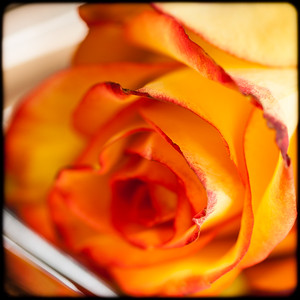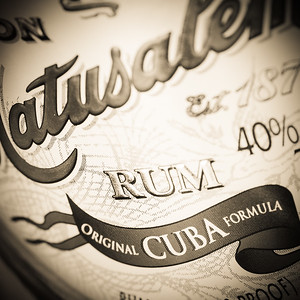The Mary Pickford cocktail is fruity and summery, a rum and pineapple forerunner of the tiki concept. And April 8 is Mary Pickford’s birthday, so let’s make some.
Mary Pickford was one of the first modern media celebrities, “America’s Sweetheart.” (She was from Toronto; it’s curious that I’ve never seen a reference to “Canada’s Sweetheart.”) She was the first of the great movie starlets—her bio at Wikipedia suggests that during WWI her fame was rivaled only by Charlie Chaplin’s.
Ah, celebrity! In addition to adoring fans, it seems to attract bartenders, and that brings us to the origin of the Mary Pickford cocktail.
In the early 1920s, Havana was a favored destination of those with the money to escape Prohibition, and the Hotel Sevilla (at that time, the Sevilla-Biltmore), on the Trocadero, just up the block from the famous Sloppy Joe’s, had one of the better bars in the city. It seems that Pickford, with husband Douglas Fairbanks Sr. in tow, visited the hotel bar in 1922 or ’23, and there met barman Fred Kaufman. It was Kaufman who first made the Mary Pickford cocktail, to commemorate the occasion.
 The recipe wasn’t published until 1928, when journalist Basil Woon recorded it in When It’s Cocktail Time in Cuba. I have never seen a copy of the original, but according to Difford’s Guide, Woon described the cocktail as “two-thirds pineapple juice and one-third Bacardi, with a dash of grenadine.”
The recipe wasn’t published until 1928, when journalist Basil Woon recorded it in When It’s Cocktail Time in Cuba. I have never seen a copy of the original, but according to Difford’s Guide, Woon described the cocktail as “two-thirds pineapple juice and one-third Bacardi, with a dash of grenadine.”
Assuming he got it right, that is a very sweet, very fruity, and insidiously drinkable cocktail. The kind you’d suck down all afternoon, and then wonder why you couldn’t get up. The rum is nearly imperceptible. I’m told the specified Bacardi of the Prohibition era had considerably more presence than the modern kind, but at 2:1, the Mary Pickford would still have tasted like a glass of pineapple juice with a bit of sweetener.
Unbalanced drinks just beg for barroom tinkering, and it was only two years later that Harry Craddock presented an evolved version in The Savoy Cocktail Book (1930). The Savoy version is the one you’re likely to encounter in the wild, and it includes two changes from the original: it has equal portions of rum and juice, and there are “6 drops” of Maraschino to round out the flavor.

(Craddock, The Savoy Cocktail Book)
- ½ Bacardi rum (1½ oz Ron Matusalem Platino)
- ½ Pineapple juice (1½ oz pineapple juice, fresh if possible)
- 1 tsp grenadine
- 6 drops Maraschino (Luxardo Maraschino)
(The Savoy offers no mixing instructions, but as usual: shake all ingredients with ice until cold, and strain into a chilled cocktail stem. Optionally, garnish with brandied cherry.
This equal-parts version works a lot better, but still leaves room for tinkering. The pineapple still dominates the drink, and the rum just barely announces itself. Some modern recipes suggest a 2:1 proportion of rum to pineapple, and I tend towards that combination myself, since it lets the rum come forward just enough to draw a little attention to itself. I really like this drink with the Ron Matusalem—it’s light and clean, not particularly sweet, and works well with either the 1:1 or 2:1 (rum:pineapple) proportions.
 (Of course, if you live in a part of the world where you can get proper Cuban rum, then that would be the right thing to experiment with, in the spirit of Havana originals.)
(Of course, if you live in a part of the world where you can get proper Cuban rum, then that would be the right thing to experiment with, in the spirit of Havana originals.)
The grenadine is sort of a throwaway here; you don’t really need it as a sweetener; there isn’t really enough to change the color of the drink to, say, a nice Mary Pickford-esque pink; and unless you like the style of grenadine that tastes more like cooked molasses than pomegranates, it adds hardly any flavor.
The Maraschino is an excellent addition. It adds depth and complexity to the flavor, and keeps the Mary Pickford from being a one-dimensional fruit bomb. But Craddock was right—just a few drops is all you need.
The nose of the Mary Pickford is all pineapple, with just a hint of cherry from the Maraschino (and the cherry garnish). It is a very simple nose, redolent of fruity sweetness, with little indication of the white rum under the fruit.
The flavor is more complex; the Mary Pickford is unquestionably one of Kaufman’s hallmark pineapple drinks, but the rum should come forward just enough to show its presence, and the Maraschino—a delicate balancing act—just enough to keep the drink from being all fruit, and to give the flavor a little “bottom.”
And if, like my bride, you revile Maraschino, you can leave it out altogether, and still be true to the “original” formulation of the drink. Very convenient, very legit, and very drinkable, even if a bit less complex.
“The Mary Pickford Cocktail” at cold-glass.com : All text and photos © 2014 Douglas M. Ford. All rights reserved.

I haven’t tried this one, looks pretty and delicious!
They’re quick and easy to make, I hope you enjoy it!
Glad to see some recipes that don’t involve lime juice, considering the nation’s current lime crisis! While I can still find them, they’ve doubled in price. I’ve told the Missus that she’s going to have to develop a taste for lemon in her gin and tonic, or find another summer favorite this year.
Yes, I’m not looking forward to a Mai Tai free summer, but perhaps pineapple will distract me…
Great post. I agree with your tendency to use a higher ratio of rum to pineapple juice; however, I go with a tad more maraschino: 2 oz. rum, ¾ oz. pineapple juice, ¼ oz. maraschino, ¼ oz. housemade grenadine.
Also, these photos are stunning. The cherries… my goodness, the cherries.
Maraschino is definitely a “season to taste” type of ingredient. I like just enough to put a stop to pineapple sweetness, but I’ve never learned to really love Maraschino enough to let it dominate a drink. On the other hand, I do seem to use more than I used to, though…
I like doing up my own cherries, but the ones in these photos happen to be Luxardo’s.
I’m glad you like the photos, thanks for mentioning.
One of my very favorite drinks. Thanks for the history on it!
You’re welcome, and thanks for commenting.
Great post! I’m writing up this cocktail for my blog, and I’m curious about its history. There seem to be two origin stories floating around, the other being that Eddie Woelke created it. Would you mind sharing what made you think that the Fred Kaufman version is more likely?
Thanks!
Katie
http://www.garnishblog.com
Hi, Katie, thanks for taking time to comment; I look forward to your Mary Pickford writeup.
I agree, there are (at least) two attributions for the drink’s creation—Woelke and Kaufman. I based my Kaufman statement on a passage in Jeff Berry’s Potions of the Caribbean (p. 112), where he signs on to Basil Woon’s Kaufman attribution in Woon’s 1928 When It’s Cocktail Time in Cuba.
Berry’s is a passing reference, buried in a discussion of the Hotel Nacional Special, but I defer to his judgment in this case—he’s studied these characters much more deeply than I. And they do seem to be characters…